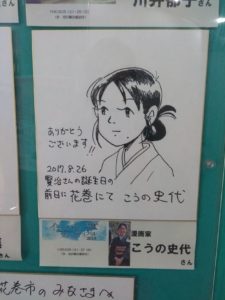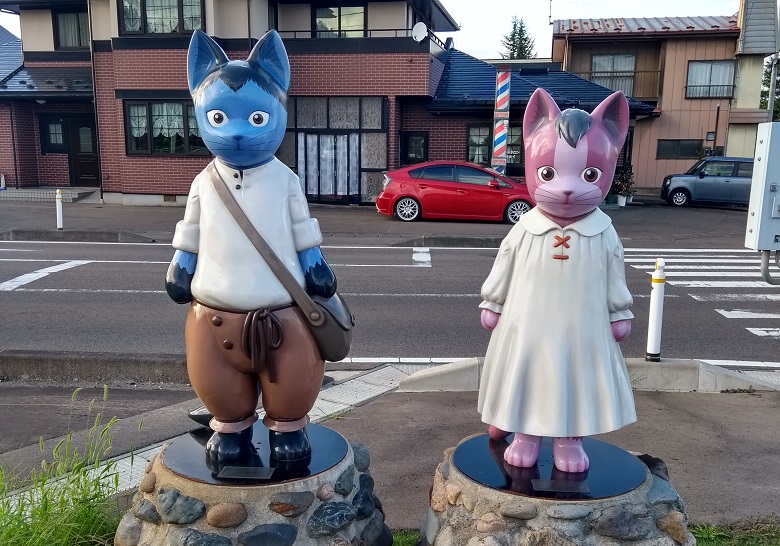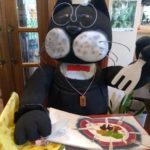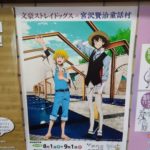This is the last out of three planned post about Kenji Miyazawa.
1) The Life, Works and Themes of Kenji Miyazawa
2) Kenji Miyazawa in Anime and Manga: Adaptions and Influence
3) A Trip to Kenji Miyazawa’s Beautiful Hometown Hanamaki
I chose to do the Kenji Miyazawa Theme Week because it aligned favorably with my plans to visit Iwate prefecture, so on my last day I spent a night in Hanamaki, Kenji Miyazawa’s home town.
It’s a small, serene place without the bustle of the big cities. And let me tell you, they’re proud of their Kenji. I arrived in the evening and was lucky enough to catch some fireworks on the horizon. Already at the station I found various posters promoting Miyazawa-related events.
Various places in Hanamaki are named after things in Miyazawa’s storiesy – the Ginga Mall, for example. You will find Miyazawa-themed decorations anywhere – lampposts, benches, sculptures, anything.

But the main attractions are obviously the Kenji Miyazawa Memorial Museum and the Fairy Tale Village (Dōwa Mura).
There’s a special train, the SL Ginga, that’s going from Hanamaki to Kamaishi and back every weekend. Since Miyazawa studied Esperanto, all stations on the way have an Esperanto name attached to them – for example, Shin-Hanamaki becomes “Stellario” with the kanji 星座 (star sign). I would have loved to ride this event train with its interior modeled after real trains from around 100 years ago. Maybe next time!

The Memorial Museum is a beautiful place, located on top of a hill with a panoramic view on the surrounding idyll. A wooden staircase leads there and on every stair, one character of Miyazawa’s famous poem Ame ni mo Makezu is written, for a total for 367 stairs.
Entry is free and it feels like everything is crafted with love. There’s a restaurant, too, named Wild Cat House after the restaurant in The Restaurant of Many Orders. The souvenir shop has all kinds of goods and I took the chance to buy some books and a Night on the Galactic Railroad pin.
The main building had a lot of information on Miyazawa and original material on display. Apparently an English online guide exists, but inside most things are Japanese-only. Displayed were things such as letters Miyazawa wrote to one of his students or photos of the people close to him.
I then visited the Fairy Tale Village, a small Miyazawa-themed park with food stalls, a big stage, a big model train, ponds and various buildings – a great place for parents with children. The main building had one room with giant toy insects that was slightly eerie while another was dark and full of mirrors with lights imitating the night sky.
 Here I also found messages from various notable Japanese personalities, including the late Ghibli director Isao Takahata, producer Toshio Suzuki, composer Joe Hisaishi, In This Corner of the World director Sunao Katabuchi, mangaka Fumiyo Kōno, composer kotringo. I was amazed how many of these names were familiar to me.
Here I also found messages from various notable Japanese personalities, including the late Ghibli director Isao Takahata, producer Toshio Suzuki, composer Joe Hisaishi, In This Corner of the World director Sunao Katabuchi, mangaka Fumiyo Kōno, composer kotringo. I was amazed how many of these names were familiar to me.
I took my time to walk around and enjoy every bit of it and if I had had more time, I would have gladly stayed longer. Most of the popular tourist spots in Japan can be pretty crowded and I find myself enjoying places like Hanamaki a lot more. Here I can relax and enjoy the atmosphere. If I lived here, I could see myself coming regularly, maybe reading book on a bench overlooking the fields and forests of Hanamaki. It’s definitely high on my list of places I want to re-visit when I’m coming to Japan again.
Riding through the prefecture on the local train lines also proved to be an excellent decision as the panoramic mountain and forest views were simply stunning at times, especially between Morioka and Miyako.
I’m glad I was able to visit Hanamaki. Tourism information in English is sparse and it’s not really a popular destination for foreigners, so I was not entirely sure what to expect. But both the town itself and the Kenji Miyazawa Memorial Museum / Fairy Tale Village were lovely and quickly became one of my favorite places in Japan.
That concludes my posts on Kenji Miyazawa. It was my first theme week and I consider it a success. Having a theme and a goal definitely boosts my motivation to tackle thing I’ve been wanting to do for a long time. What definitely still needs to be improved is timely coverage – this took far longer than it should’ve taken and I also went into more detail than originally anticipated. But there will be more theme weeks and I’ll try my best to not procrastinate the writing part too much next time.



























